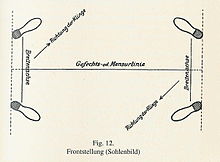Scale length (fencing)
In fencing, the length of the scale is generally the distance between two fencers.
A distinction is made between the narrow or short scale , the medium scale and the wide scale .
- Narrow or short length: The fencers can meet with one another with an outstretched arm.
- Medium length: You can hit the opponent with an extended arm plus a lunge or one step forward .
- Wide scale: In addition to the outstretched arm and the step in front , a lunge or a jump forward plus lunge ( ballestra ) is necessary for a hit . In individual cases, instead of jumping to the front, a repositioning plus failure is sufficient .

Fencing position at the academic scale
In academic or student fencing, the fencers face each other on a short scale which - at least during a course - must not be left ("fixed scale" as opposed to "loose scale" in sport fencing). This type of duel is therefore also referred to as a scale length pars pro toto .
Fixed scale for a student scale
literature
- William M. Gaugler: Fencing: For beginners and advanced. Foil, saber, sword. Verlag Nymphenburger, 2004, ISBN 978-3-485-01020-7 .


